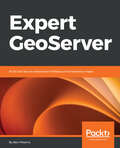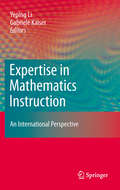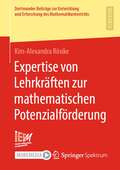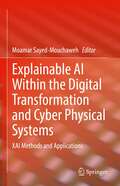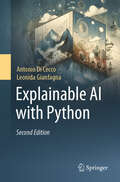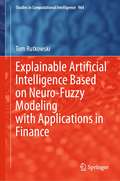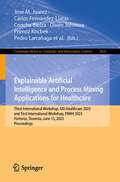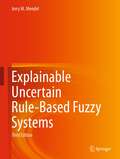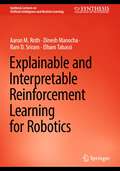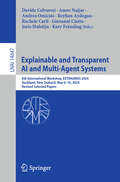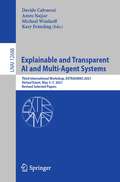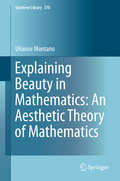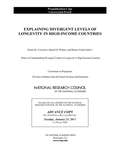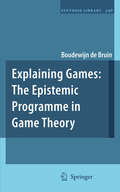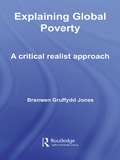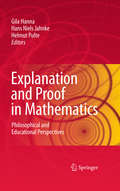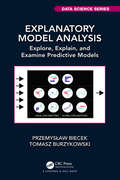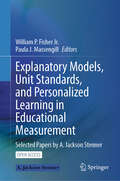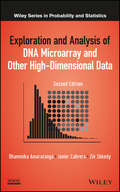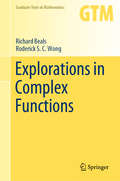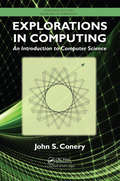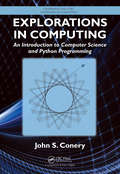- Table View
- List View
Expert GeoServer: Build and secure advanced interfaces and interactive maps
by Ben MearnsA fast-paced guide to putting your GeoServer-based application into fast, user-friendly, and secure productionKey Features Resolve bottlenecks, optimize data stores, and cluster server resources Use identity management and authentication for a user-specific, secure web application Go beyond traditional web hosting to explore the full range of hosting options in the cloudBook DescriptionGeoServer is open source, server-side software written in Java that allows users to share and edit geospatial data. In this book, you'll start by learning how to develop a spatial analysis platform with web processing services. Then you'll see how to develop an algorithm by chaining together geospatial analysis processes, which you can share with anyone in the world. Next you'll delve into a very important technique to improve the speed of your map application—tile caching. Here, you'll understand how tile caching works, how to develop an effective tile cache-supported web service, and how to leverage tile caching in your OpenLayers web application.Further on, you'll explore important tweaks to produce a performant GeoServer-backed web mapping application. Moving on, you'll enable authentication on the frontend and backend to protect sensitive map data, and deliver sensitive data to your end user. Finally, you'll see how to put your web application into production in a secure and user-friendly way. You'll go beyond traditional web hosting to explore the full range of hosting options in the cloud, and maintain a reliable server instance.What you will learn Develop a WPS-processing service to allow web-based geospatial data processing Get to know important techniques to improve the speed of your web map application—tile caching, raster data optimization, and server clustering Find out which GeoServer settings resolve bottlenecks Develop an algorithm by chaining geospatial analysis processes together Put your application into production with hosting, monitoring, and automated backup and recovery Understand how to develop an effective tile cache-supported web service Master techniques that ensure resilient server deploymentWho this book is forThis book is for anyone who wants to learn about advanced interfaces, security, and troubleshooting techniques in GeoServer. A basic understanding of GeoServer is required
Expertise in Mathematics Instruction
by Yeping Li Gabriele KaiserAccumulated research findings in past decades have led to the common knowledge that teachers' professional knowledge is essential to effective classroom instruction. However, there is still very limited understanding about the nature of teachers' expertise in mathematics instruction. Expertise in Mathematics Instruction addresses this need clearly and concisely. In particular, it examines all aspects of emphases employed to characterize the nature of expertise in mathematics instruction from both researchers' and practitioners' perspectives. Moreover, with research contributions from both the East and the West, this book also examines ideas pertinent to fostering and demonstrating expertise in mathematics instruction within different system contexts. This book will raise questions and issues for mathematics education researchers to guide a critical examination of what can be learned from other education systems. Expertise in Mathematics Instruction builds on its theoretical and methodological approach with contributions from international experts in the field. Additionally, a review of related research from mathematics education serves as an introduction to the new research in both Eastern and Western settings. Concluding this resource is a reflection on the benefits of this international collaboration and possible research directions for the future. The final chapter cohesively joins traditional and current research for action. Expertise in Mathematics Instruction is of interest to researchers in mathematics education, mathematics teacher educators, and mathematics educators.
Expertise von Lehrkräften zur mathematischen Potenzialförderung (Dortmunder Beiträge zur Entwicklung und Erforschung des Mathematikunterrichts #47)
by Kim-Alexandra RösikeDie schulischen Förderprogramme für Lernende mit mathematischen Potenzialen fokussiert in Deutschland noch immer zum großen Teil diejenigen Lernenden, die bereits durch stabil gute Leistungen auffallen. Unter Annahme des partizipativen und dynamischen Potenzialbegriffs können jedoch potenzialförderliche Unterrichtskonzepte etabliert werden, die es einer größeren Anzahl von Lernenden ermöglicht, ihre Potenziale zu entwickeln und zu stabilisieren. Dieses Buch beschäftigt sich mit der für den potenzialförderlichen Unterricht notwendigen Expertise von Lehrkräften. Dazu wird ein gegenstandsspezifisches Design-Research-Projekt durchgeführt, das sowohl die Expertise von Lehrkräften differenziert beschreibt und rekonstruiert, als auch eine Fortbildung zur mathematischen Potenzialförderung entwickelt. Durch die empirischen Analysen können drei zentrale Leitkategorien als strukturgebendes Element der Expertise von Lehrkräften rekonstruiert werden, die ihr Denken und Wahrnehmen leiten. Die daraus resultierenden Diagnose- und Förderpraktiken tragen maßgeblich zu einem tieferen Verständnis der Expertise bei und ermöglichen die Entwicklung konkreter gegenstandsspezifischer Designelemente für die Fortbildung.
Explainable AI Within the Digital Transformation and Cyber Physical Systems: XAI Methods and Applications
by Moamar Sayed-MouchawehThis book presents Explainable Artificial Intelligence (XAI), which aims at producing explainable models that enable human users to understand and appropriately trust the obtained results. The authors discuss the challenges involved in making machine learning-based AI explainable. Firstly, that the explanations must be adapted to different stakeholders (end-users, policy makers, industries, utilities etc.) with different levels of technical knowledge (managers, engineers, technicians, etc.) in different application domains. Secondly, that it is important to develop an evaluation framework and standards in order to measure the effectiveness of the provided explanations at the human and the technical levels. This book gathers research contributions aiming at the development and/or the use of XAI techniques in order to address the aforementioned challenges in different applications such as healthcare, finance, cybersecurity, and document summarization. It allows highlighting the benefits and requirements of using explainable models in different application domains in order to provide guidance to readers to select the most adapted models to their specified problem and conditions.Includes recent developments of the use of Explainable Artificial Intelligence (XAI) in order to address the challenges of digital transition and cyber-physical systems;Provides a textual scientific description of the use of XAI in order to address the challenges of digital transition and cyber-physical systems;Presents examples and case studies in order to increase transparency and understanding of the methodological concepts.
Explainable AI with Python
by Leonida Gianfagna Antonio Di CeccoThis comprehensive book on Explainable Artificial Intelligence has been updated and expanded to reflect the latest advancements in the field of XAI, enriching the existing literature with new research, case studies, and practical techniques. The Second Edition expands on its predecessor by addressing advancements in AI, including large language models and multimodal systems that integrate text, visual, auditory, and sensor data. It emphasizes making complex systems interpretable without sacrificing performance and provides an enhanced focus on additive models for improved interpretability. Balancing technical rigor with accessibility, the book combines theory and practical application to equip readers with the skills needed to apply explainable AI (XAI) methods effectively in real-world contexts. Features: Expansion of the "Intrinsic Explainable Models" chapter to delve deeper into generalized additive models and other intrinsic techniques, enriching the chapter with new examples and use cases for a better understanding of intrinsic XAI models. Further details in "Model-Agnostic Methods for XAI" focused on how explanations differ between the training set and the test set, including a new model to illustrate these differences more clearly and effectively. New section in "Making Science with Machine Learning and XAI" presenting a visual approach to learning the basic functions in XAI, making the concept more accessible to readers through an interactive and engaging interface. Revision in "Adversarial Machine Learning and Explainability" that includes a code review to enhance understanding and effectiveness of the concepts discussed, ensuring that code examples are up-to-date and optimized for current best prac
Explainable Artificial Intelligence Based on Neuro-Fuzzy Modeling with Applications in Finance (Studies in Computational Intelligence #964)
by Tom RutkowskiThe book proposes techniques, with an emphasis on the financial sector, which will make recommendation systems both accurate and explainable. The vast majority of AI models work like black box models. However, in many applications, e.g., medical diagnosis or venture capital investment recommendations, it is essential to explain the rationale behind AI systems decisions or recommendations. Therefore, the development of artificial intelligence cannot ignore the need for interpretable, transparent, and explainable models. First, the main idea of the explainable recommenders is outlined within the background of neuro-fuzzy systems. In turn, various novel recommenders are proposed, each characterized by achieving high accuracy with a reasonable number of interpretable fuzzy rules. The main part of the book is devoted to a very challenging problem of stock market recommendations. An original concept of the explainable recommender, based on patterns from previous transactions, is developed; it recommends stocks that fit the strategy of investors, and its recommendations are explainable for investment advisers.
Explainable Artificial Intelligence and Process Mining Applications for Healthcare: Third International Workshop, XAI-Healthcare 2023, and First International Workshop, PM4H 2023, Portoroz, Slovenia, June 15, 2023, Proceedings (Communications in Computer and Information Science #2020)
by Pedro Larrañaga Concha Bielza Alfredo Vellido Jorge Munoz-Gama Jose M. Juarez Carlos Fernandez-Llatas Owen Johnson Primoz Kocbek Niels Martin Gregor Štiglic Marcos SepulvedaThis book constitutes the proceedings of the Third International Workshop on Explainable Artificial Intelligence in Healthcare, XAI-Healthcare 2023, and the First International Workshop on Process Mining Applications for Healthcare, PM4H 2023, which took place in conjunction with AIME 2023 in Portoroz, Slovenia, on June 15, 2023.The 7 full papers included from XAI-Healthcare were carefully reviewed and selected from 11 submissions. They focus on all aspects of eXplainable Artificial Intelligence (XAI) in the medical and healthcare field. For PM4H 5 papers have been accepted from 17 submissions. They deal with data-driven process analysis techniques in healthcare.
Explainable Uncertain Rule-Based Fuzzy Systems
by Jerry M. MendelThe third edition of this textbook presents a further updated approach to fuzzy sets and systems that can model uncertainty — i.e., “type-2” fuzzy sets and systems. The author demonstrates how to overcome the limitations of classical fuzzy sets and systems, enabling a wide range of applications, from time-series forecasting to knowledge mining to classification to control and to explainable AI (XAI). This latest edition again begins by introducing classical (type-1) fuzzy sets and systems, and then explains how they can be modified to handle uncertainty, leading to type-2 fuzzy sets and systems. New material is included about how to obtain fuzzy set word models that are needed for XAI, similarity of fuzzy sets, a quantitative methodology that lets one explain in a simple way why the different kinds of fuzzy systems have the potential for performance improvements over each other, and new parameterizations of membership functions that have the potential for achieving even greater performance for all kinds of fuzzy systems. For hands-on experience, the book provides information on accessing MATLAB, Java, and Python software to complement the content. The book features a full suite of classroom material.
Explainable and Customizable Job Sequencing and Scheduling: Advancing Production Control and Management with XAI (SpringerBriefs in Applied Sciences and Technology)
by Tin-Chih Toly ChenThis book systematically reviews the progress in explainable AI (XAI) and introduces the methods, tools, and applications of XAI technologies in job sequencing and scheduling. Relevant references and real case studies are provided as supporting evidence. To date, artificial intelligence (AI) technologies have been widely applied in job sequencing and scheduling. However, some advanced AI methods are not easy to understand or communicate, especially for factory workers with insufficient background knowledge of AI. This undoubtedly limits the practicability of these methods. To address this issue, explainable AI has been considered a viable strategy. XAI methods suitable for job sequencing and scheduling differ from those for other fields in manufacturing, such as pattern recognition, defect analysis, estimation, and prediction. This is the first book to systematically integrate current knowledge in XAI and demonstrate its application to manufacturing.
Explainable and Interpretable Reinforcement Learning for Robotics (Synthesis Lectures on Artificial Intelligence and Machine Learning)
by Dinesh Manocha Aaron M. Roth Ram D. Sriram Elham TabassiThis book surveys the state of the art in explainable and interpretable reinforcement learning (RL) as relevant for robotics. While RL in general has grown in popularity and been applied to increasingly complex problems, several challenges have impeded the real-world adoption of RL algorithms for robotics and related areas. These include difficulties in preventing safety constraints from being violated and the issues faced by systems operators who desire explainable policies and actions. Robotics applications present a unique set of considerations and result in a number of opportunities related to their physical, real-world sensory input and interactions. The authors consider classification techniques used in past surveys and papers and attempt to unify terminology across the field. The book provides an in-depth exploration of 12 attributes that can be used to classify explainable/interpretable techniques. These include whether the RL method is model-agnostic or model-specific, self-explainable or post-hoc, as well as additional analysis of the attributes of scope, when-produced, format, knowledge limits, explanation accuracy, audience, predictability, legibility, readability, and reactivity. The book is organized around a discussion of these methods broken down into 42 categories and subcategories, where each category can be classified according to some of the attributes. The authors close by identifying gaps in the current research and highlighting areas for future investigation.
Explainable and Transparent AI and Multi-Agent Systems: 6th International Workshop, EXTRAAMAS 2024, Auckland, New Zealand, May 6–10, 2024, Revised Selected Papers (Lecture Notes in Computer Science #14847)
by Andrea Omicini Davide Calvaresi Amro Najjar Kary Främling Reyhan Aydogan Rachele Carli Giovanni Ciatto Joris HulstijnThis volume constitutes the papers of several workshops which were held in conjunction with the 6th International Workshop on Explainable and Transparent AI and Multi-Agent Systems, EXTRAAMAS 2024, in Auckland, New Zealand, during May 6–10, 2024. The 13 full papers presented in this book were carefully reviewed and selected from 25 submissions. The papers are organized in the following topical sections: User-centric XAI; XAI and Reinforcement Learning; Neuro-symbolic AI and Explainable Machine Learning; and XAI & Ethics.
Explainable and Transparent AI and Multi-Agent Systems: Third International Workshop, EXTRAAMAS 2021, Virtual Event, May 3–7, 2021, Revised Selected Papers (Lecture Notes in Computer Science #12688)
by Davide Calvaresi Amro Najjar Kary Främling Michael WinikoffThis book constitutes the proceedings of the Third International Workshop on Explainable, Transparent AI and Multi-Agent Systems, EXTRAAMAS 2021, which was held virtually due to the COVID-19 pandemic.The 19 long revised papers and 1 short contribution were carefully selected from 32 submissions. The papers are organized in the following topical sections: XAI & machine learning; XAI vision, understanding, deployment and evaluation; XAI applications; XAI logic and argumentation; decentralized and heterogeneous XAI.
Explaining Beauty in Mathematics: An Aesthetic Theory of Mathematics
by Ulianov MontanoThis book develops a naturalistic aesthetic theory that accounts for aesthetic phenomena in mathematics in the same terms as it accounts for more traditional aesthetic phenomena. Building upon a view advanced by James McAllister, the assertion is that beauty in science does not confine itself to anecdotes or personal idiosyncrasies, but rather that it had played a role in shaping the development of science. Mathematicians often evaluate certain pieces of mathematics using words like beautiful, elegant, or even ugly. Such evaluations are prevalent, however, rigorous investigation of them, of mathematical beauty, is much less common. The volume integrates the basic elements of aesthetics, as it has been developed over the last 200 years, with recent findings in neuropsychology as well as a good knowledge of mathematics. The volume begins with a discussion of the reasons to interpret mathematical beauty in a literal or non-literal fashion, which also serves to survey historical and contemporary approaches to mathematical beauty. The author concludes that literal approaches are much more coherent and fruitful, however, much is yet to be done. In this respect two chapters are devoted to the revision and improvement of McAllister's theory of the role of beauty in science. These antecedents are used as a foundation to formulate a naturalistic aesthetic theory. The central idea of the theory is that aesthetic phenomena should be seen as constituting a complex dynamical system which the author calls the aesthetic as process theory. The theory comprises explications of three central topics: aesthetic experience (in mathematics), aesthetic value and aesthetic judgment. The theory is applied in the final part of the volume and is used to account for the three most salient and often used aesthetic terms often used in mathematics: beautiful, elegant and ugly. This application of the theory serves to illustrate the theory in action, but also to further discuss and develop some details and to showcase the theory's explanatory capabilities.
Explaining Beauty in Mathematics: An Aesthetic Theory of Mathematics (Synthese Library #370)
by Ulianov MontanoThis book develops a naturalistic aesthetic theory that accounts for aesthetic phenomena in mathematics in the same terms as it accounts for more traditional aesthetic phenomena. Building upon a view advanced by James McAllister, the assertion is that beauty in science does not confine itself to anecdotes or personal idiosyncrasies, but rather that it had played a role in shaping the development of science. Mathematicians often evaluate certain pieces of mathematics using words like beautiful, elegant, or even ugly. Such evaluations are prevalent, however, rigorous investigation of them, of mathematical beauty, is much less common. The volume integrates the basic elements of aesthetics, as it has been developed over the last 200 years, with recent findings in neuropsychology as well as a good knowledge of mathematics.The volume begins with a discussion of the reasons to interpret mathematical beauty in a literal or non-literal fashion, which also serves to survey historical and contemporary approaches to mathematical beauty. The author concludes that literal approaches are much more coherent and fruitful, however, much is yet to be done. In this respect two chapters are devoted to the revision and improvement of McAllister’s theory of the role of beauty in science. These antecedents are used as a foundation to formulate a naturalistic aesthetic theory. The central idea of the theory is that aesthetic phenomena should be seen as constituting a complex dynamical system which the author calls the aesthetic as process theory.The theory comprises explications of three central topics: aesthetic experience (in mathematics), aesthetic value and aesthetic judgment. The theory is applied in the final part of the volume and is used to account for the three most salient and often used aesthetic terms often used in mathematics: beautiful, elegant and ugly. This application of the theory serves to illustrate the theory in action, but also to further discuss and develop some details and to showcase the theory’s explanatory capabilities.
Explaining Divergent Levels of Longevity in High-Income Countries
by National Research Council of the National AcademiesOver the last 25 years life expectancy at age 50 in the U.S. has been rising but at a slower pace than in many other high-income countries such as Japan and Australia. This difference is particularly notable given that the U.S. spends more on health care than any other nation. Concerned about this divergence the National Institute on Aging asked the National Research Council to examine evidence on its possible causes. According to Explaining Divergent Levels of Longevity in High-Income Countries the nation's history of heavy smoking is a major reason why lifespans in the U.S. fall short of those in many other high-income nations. Evidence suggests that current obesity levels play a substantial part as well. The book reports that lack of universal access to health care in the U.S. also has increased mortality and reduced life expectancy though this is a less significant factor for those over age 65 because of Medicare access. For the main causes of death at older ages -- cancer and cardiovascular disease -- available indicators do not suggest that the U.S. health care system is failing to prevent deaths that would be averted elsewhere. In fact cancer detection and survival appear to be better in the U.S. than in most other high-income nations and survival rates following a heart attack also are favorable. Explaining Divergent Levels of Longevity in High-Income Countries identifies many gaps in research. For instance while lung cancer deaths are a reliable marker of the damage from smoking no clear-cut marker exists for obesity physical inactivity social integration or other risks considered in this book. Moreover evaluation of these risk factors is based on observational studies which -- unlike randomized controlled trials -- are subject to many biases.
Explaining Games
by Boudewijn De BruinDoes game theory - the mathematical theory of strategic interaction - provide genuine explanations of human behaviour? Can game theory be used in economic consultancy or other normative contexts? Explaining Games: The Epistemic Programme in Game Theory - the first monograph on the philosophy of game theory - is a bold attempt to combine insights from epistemic logic and the philosophy of science to investigate the applicability of game theory in such fields as economics, philosophy and strategic consultancy. De Bruin proves new mathematical theorems about the beliefs, desires and rationality principles of individual human beings, and he explores in detail the logical form of game theory as it is used in explanatory and normative contexts. He argues that game theory reduces to rational choice theory if used as an explanatory device, and that game theory is nonsensical if used as a normative device. A provocative account of the history of game theory reveals that this is not bad news for all of game theory, though. Two central research programmes in game theory tried to find the ultimate characterisation of strategic interaction between rational agents. Yet, while the Nash Equilibrium Refinement Programme has done badly thanks to such research habits as overmathematisation, model-tinkering and introversion, the Epistemic Programme, De Bruin argues, has been rather successful in achieving this aim.
Explaining Global Poverty: A Critical Realist Approach (Routledge Studies in Critical Realism)
by Branwen Gruffydd JonesThe twenty-first century is characterized by extremes of poverty and wealth, of scarcity and abundance. The vast inequalties of wealth distribution between the developed west and the impoverished developing world is a complex problem. This book recognises that Africa in particular has manifested this global disgrace and symbolizes the nature of poverty to the western world. In order to truly emancipate the poverty stricken around the world we must necessarily understand the reasons for its existence. In a departure from traditional critical realist theory, Gruffydd-Jones argues the benefits of reassessing the relevance of objective inquiry and emphasizes its primacy over normative theory in the battle to truly understand the reasons for the African crisis. This approach brings us a book of real relevance for inequality in the modern world and gives us an important platform from which to move forwards in the fight against poverty.
Explaining Psychological Statistics
by Barry H. CohenPraise for the previous edition of Explaining Psychological Statistics"I teach a master's level, one-semester statistics course, and it is a challenge to find a textbook that is at the right level. Barry Cohen's book is the best one I have found. . . . I like the fact that the chapters have different sections that allow the professor to decide how much depth of coverage to include in his/her course. . . . This is a strong and improved edition of an already good book." -Karen Caplovitz Barrett, PhD, Professor, and Assistant Department Head of Human Development and Family Studies, Colorado State University"The quality is uniformly good. . . . This is not the first statistics text I have read but it is one of the best." -Michael Dosch, PhD, MS, CRNA, Associate Professor and Chair, Nurse Anesthesia, University of Detroit MercyA clear and accessible statistics text- now fully updated and revisedNow with a new chapter showing students how to apply the right test in the right way to yield the most accurate and true result, Explaining Psychological Statistics, Fourth Edition offers students an engaging introduction to the field. Presenting the material in a logically flowing, non-intimidating way, this comprehensive text covers both introductory and advanced topics in statistics, from the basic concepts (and limitations) of null hypothesis testing to mixed-design ANOVA and multiple regression.The Fourth Edition covers:Basic statistical proceduresFrequency tables, graphs, and distributionsMeasures of central tendency and variabilityOne- and two-sample hypothesis testsHypothesis testingInterval estimation and the t distribution
Explanation and Proof in Mathematics
by Helmut Pulte Hans Niels Jahnke Gila HannaIn the four decades since Imre Lakatos declared mathematics a "quasi-empirical science," increasing attention has been paid to the process of proof and argumentation in the field -- a development paralleled by the rise of computer technology and the mounting interest in the logical underpinnings of mathematics. Explanantion and Proof in Mathematics assembles perspectives from mathematics education and from the philosophy and history of mathematics to strengthen mutual awareness and share recent findings and advances in their interrelated fields. With examples ranging from the geometrists of the 17th century and ancient Chinese algorithms to cognitive psychology and current educational practice, contributors explore the role of refutation in generating proofs, the varied links between experiment and deduction, the use of diagrammatic thinking in addition to pure logic, and the uses of proof in mathematics education (including a critique of "authoritative" versus "authoritarian" teaching styles). A sampling of the coverage: The conjoint origins of proof and theoretical physics in ancient Greece. Proof as bearers of mathematical knowledge. Bridging knowing and proving in mathematical reasoning. The role of mathematics in long-term cognitive development of reasoning. Proof as experiment in the work of Wittgenstein. Relationships between mathematical proof, problem-solving, and explanation. Explanation and Proof in Mathematics is certain to attract a wide range of readers, including mathematicians, mathematics education professionals, researchers, students, and philosophers and historians of mathematics.
Explanatory Model Analysis: Explore, Explain, and Examine Predictive Models (Chapman & Hall/CRC Data Science Series)
by Tomasz Burzykowski Przemyslaw BiecekExplanatory Model Analysis Explore, Explain and Examine Predictive Models is a set of methods and tools designed to build better predictive models and to monitor their behaviour in a changing environment. Today, the true bottleneck in predictive modelling is neither the lack of data, nor the lack of computational power, nor inadequate algorithms, nor the lack of flexible models. It is the lack of tools for model exploration (extraction of relationships learned by the model), model explanation (understanding the key factors influencing model decisions) and model examination (identification of model weaknesses and evaluation of model's performance). This book presents a collection of model agnostic methods that may be used for any black-box model together with real-world applications to classification and regression problems.
Explanatory Models, Unit Standards, and Personalized Learning in Educational Measurement: Selected Papers by A. Jackson Stenner
by William P. Fisher Paula J. MassengillThe papers by Jack Stenner included in this book document the technical details of an art and science of measurement that creates new entrepreneurial business opportunities. Jack brought theory, instruments, and data together in ways that are applicable not only in the context of a given test of reading or mathematics ability, but which more importantly catalyzed literacy and numeracy capital in new fungible expressions. Though Jack did not reflect in writing on the inferential, constructive processes in which he engaged, much can be learned by reviewing his work with his accomplishments in mind. A Foreword by Stenner's colleague and co-author on multiple works, William P. Fisher, Jr., provides key clues concerning (a) how Jack's understanding of measurement and its values aligns with social and historical studies of science and technology, and (b) how recent developments in collaborations of psychometricians and metrologists are building on and expanding Jack's accomplishments. This is an open access book.
Exploration and Analysis of DNA Microarray and Other High-Dimensional Data
by Dhammika Amaratunga Ziv Shkedy Javier CabreraExploration and Analysis of DNA Microarray and Other High-Dimensional Data, Second Edition provides comprehensive coverage of recent advancements in microarray data analysis. A cutting-edge guide, the Second Edition demonstrates various methodologies for analyzing data in biomedical research and offers an overview of the modern techniques used in microarray technology to study patterns of gene activity. The new edition answers the need for an efficient outline of all phases of this revolutionary analytical technique, from preprocessing to the analysis stage. Utilizing research and experience from highly-qualified authors in fields of data analysis, Exploration and Analysis of DNA Microarray and Other High-Dimensional Data, Second Edition features: A new chapter on the interpretation of findings that includes a discussion of signatures and material on gene set analysis, including network analysisNew topics of coverage including ABC clustering, biclustering, partial least squares, penalized methods, ensemble methods, and enriched ensemble methodsUpdated exercises to deepen knowledge of the presented material and provide readers with resources for further study The book is an ideal reference for scientists in biomedical and genomics research fields who analyze DNA microarrays and protein array data, as well as statisticians and bioinformatics practitioners. Exploration and Analysis of DNA Microarray and Other High-Dimensional Data, Second Edition is also a useful text for graduate-level courses on statistics, computational biology, and bioinformatics.
Explorations in Complex Functions (Graduate Texts in Mathematics #287)
by Richard Beals Roderick S. WongThis textbook explores a selection of topics in complex analysis. From core material in the mainstream of complex analysis itself, to tools that are widely used in other areas of mathematics, this versatile compilation offers a selection of many different paths. Readers interested in complex analysis will appreciate the unique combination of topics and connections collected in this book. Beginning with a review of the main tools of complex analysis, harmonic analysis, and functional analysis, the authors go on to present multiple different, self-contained avenues to proceed. Chapters on linear fractional transformations, harmonic functions, and elliptic functions offer pathways to hyperbolic geometry, automorphic functions, and an intuitive introduction to the Schwarzian derivative. The gamma, beta, and zeta functions lead into L-functions, while a chapter on entire functions opens pathways to the Riemann hypothesis and Nevanlinna theory. Cauchy transforms give rise to Hilbert and Fourier transforms, with an emphasis on the connection to complex analysis. Valuable additional topics include Riemann surfaces, steepest descent, tauberian theorems, and the Wiener–Hopf method. Showcasing an array of accessible excursions, Explorations in Complex Functions is an ideal companion for graduate students and researchers in analysis and number theory. Instructors will appreciate the many options for constructing a second course in complex analysis that builds on a first course prerequisite; exercises complement the results throughout.
Explorations in Computing: An Introduction to Computer Science (Chapman & Hall/CRC Textbooks in Computing)
by John S. ConeryBased on the author's introductory course at the University of Oregon, Explorations in Computing: An Introduction to Computer Science focuses on the fundamental idea of computation and offers insight into how computation is used to solve a variety of interesting and important real-world problems. Taking an active learning approach, the text encoura
Explorations in Computing: An Introduction to Computer Science and Python Programming (Chapman & Hall/CRC Textbooks in Computing)
by John S. ConeryAn Active Learning Approach to Teaching the Main Ideas in Computing Explorations in Computing: An Introduction to Computer Science and Python Programming teaches computer science students how to use programming skills to explore fundamental concepts and computational approaches to solving problems. Tbook gives beginning students an introduction to
